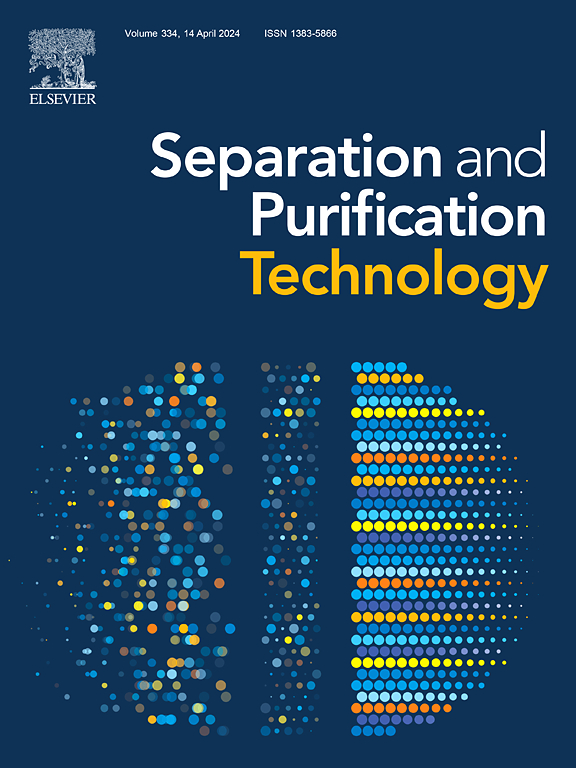废LiFePO4电池与镀铬废水协同回收:选择性锂浸出和双重废物增值的自我持续方法
IF 8.1
1区 工程技术
Q1 ENGINEERING, CHEMICAL
引用次数: 0
摘要
作为电力和储能系统的主要正极材料,磷酸铁锂(LiFePO4)电池在中国的市场份额超过70% %,预计到2030年,废旧LiFePO4 (S-LFP)废物将超过200万吨。然而,由于传统湿法冶金方法的低经济可行性和二次污染风险,S-LFP的回收仍然具有挑战性。本研究引入了一种创新的“废物协同”策略,利用含Cr(VI)的电镀废水作为自维持的浸出剂,从S-LFP阴极中选择性提取锂(92.34 %)和Cr(VI)解毒(99.11 %)。Fe(II)-Cr(VI)耦合氧化还原浸出的活化能较低(17.62 kJ/mol)。由回收的Li2CO3和FePO4再合成的LiFePO4表现出强大的电化学性能,在1C下的初始放电容量为146 mA·h·g−1,在100次循环后保持95.4 %的容量。生命周期评估和经济分析显示,对环境的影响显著减少,同时每公斤加工的S-LFP粉的净利润为1.34美元。这种自我维持的闭环方法减轻了S-LFP和Cr(VI)废水对环境的危害,同时推进了循环经济原则,为锂电池回收建立了可扩展和可持续的范例。本文章由计算机程序翻译,如有差异,请以英文原文为准。


Synergistic recycling of spent LiFePO4 batteries with chromium-plating wastewater: a self-sustained approach for selective lithium leaching and dual waste valorization
As the dominant cathode material for power and energy storage systems, lithium iron phosphate (LiFePO4) batteries hold over 70 % of the market share in China, with spent LiFePO4 (S-LFP) waste projected to exceed 2 million tons by 2030. However, recycling S-LFP remains challenging due to low economic viability and secondary pollution risks from conventional hydrometallurgical methods. This study introduces an innovative “waste-synergistic” strategy for dual waste valorization, utilizing Cr(VI)-laden electroplating wastewater as a self-sustained lixiviant to achieve selective lithium extraction (92.34 %) from S-LFP cathode and Cr(VI) detoxification (99.11 %). Redox-driven leaching via Fe(II)-Cr(VI) coupling shows low activation energy (17.62 kJ/mol). Resynthesized LiFePO4 from recycled Li2CO3 and FePO4 exhibits robust electrochemical performance, delivering an initial discharge capacity of 146 mA·h·g−1 at 1C and retaining 95.4 % capacity after 100 cycles. Life-cycle assessment and economic analysis revealed significant reductions in environmental impact, alongside a net profit of US$1.34 per kilogram of processed S-LFP powder. This self-sustained closed-loop approach mitigates environmental hazards from both S-LFP and Cr(VI) effluents while advancing circular economy principles, establishing a scalable and sustainable paradigm for lithium battery recycling.
求助全文
通过发布文献求助,成功后即可免费获取论文全文。
去求助
来源期刊

Separation and Purification Technology
工程技术-工程:化工
CiteScore
14.00
自引率
12.80%
发文量
2347
审稿时长
43 days
期刊介绍:
Separation and Purification Technology is a premier journal committed to sharing innovative methods for separation and purification in chemical and environmental engineering, encompassing both homogeneous solutions and heterogeneous mixtures. Our scope includes the separation and/or purification of liquids, vapors, and gases, as well as carbon capture and separation techniques. However, it's important to note that methods solely intended for analytical purposes are not within the scope of the journal. Additionally, disciplines such as soil science, polymer science, and metallurgy fall outside the purview of Separation and Purification Technology. Join us in advancing the field of separation and purification methods for sustainable solutions in chemical and environmental engineering.
 求助内容:
求助内容: 应助结果提醒方式:
应助结果提醒方式:


